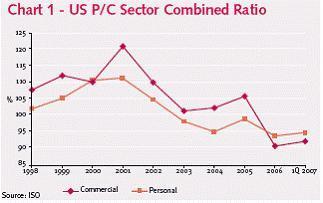Stuart Robinson looks at how insurers can use ERM to create value
Many European insurance companies have made a substantial investment in establishing a robust risk infrastructure, putting in place the building blocks for identifying, assessing, quantifying and monitoring risks. Now companies are starting to use the information this platform delivers to create value. One of the more immediate ways is to maximise the return that the business gets from taking on new risks through development of risk-based pricing techniques.
A risk-based pricing framework provides a price for insurance business which incorporates leading edge thinking on the relationship between risk, capital and value.
It makes use of market-consistent techniques for pricing risk, combined with economic capital techniques for the assessment of required capital.
Undeniably it can contribute to significant competitive advantages. Firstly, a risk-based pricing framework provides a complete economic perspective on new business profitability including the market price of the risks being taken on including options and guarantees; the economic capital required to write the product; and the cost of commission and other expenses. Secondly, a risk-based pricing approach delivers granular information at customer, product and distribution channel level, giving companies a timely understanding of the profitability at these levels. This allows them to make decisions which optimise value.
Companies can for example target profitable market niches that competitors may not be aware of; gradually surrender market share in unprofitable but ‘needed to play’ products or channels; or refine their products to further improve profitability. Companies that act early and are ahead of the game have an opportunity to gain a significant competitive advantage.
Key challenges
The sophistication of pricing frameworks varies by company. For certain products, insurers are relatively advanced and have a good understanding of customer risk characteristics. However, very few large insurers are capable of using risk-based pricing techniques to price every product in their portfolio.
Some companies appear to be held back by the fact that risk-based pricing is technically challenging and moving from a traditional pricing model to a risk-based pricing approach can present significant practical implementation challenges. The two key technical challenges are to value cashflows correctly and to calculate and allocate required economic capital.
Prior to the development of market-consistent valuation techniques, product pricing was typically based on a discounted cashflow approach using a single company-wide risk discount rate. Many companies now embrace market-consistent techniques for financial reporting purposes. This change in reporting methodology recognises that a discount rate should reflect the risk of the cashflows in a product, with options and guarantees being explicitly costed. However, pricing is a very different activity from financial reporting.
To implement a risk-based pricing framework, companies need to have product-level market-consistent valuation models, data and assumptions.
The concept of economic capital is something that insurers are increasingly comfortable with. However, the key challenges from a pricing perspective are comparatively new. Companies need to ensure that economic capital analysis is granular enough to feed into a bottom-up market-consistent valuation model, as well as understand and allow for diversification effects.
This is not easy. Economic capital models developed for regulatory or high-level risk quantification purposes may not provide product or channel level economic capital figures. Diversification in particular requires more attention, as it can significantly reduce overall capital requirements. It is often difficult to attribute diversification benefits to specific products using existing models. However, there are a number of analytical and modelling short-cuts that can help produce the required outputs.
Finally, from a technical perspective, an effective risk-based pricing framework has to pull together valuation and economic capital analysis to allow fully for the interaction between risk, capital and value. The value created for shareholders should reflect the market price of risks taken on. It also needs to take into account the cost of holding economic capital, which provides policyholders with the necessary level of protection from risks.
When companies come to use a risk-based pricing framework, they often encounter wider issues around governance, systems, operational processes and change management. Common questions include:
• Who will own the new framework?
“Very few large insurers are capable of using risk-based pricing techniques to price every product in their portfolio
Stuart Robinson is a senior consultant at Towers Perrin
• What changes to other business processes will be required?
• How much education will be needed?
• How will results be communicated?
• How will buy-in be obtained?
Compared to these implementation challenges, getting the technical framework right is easy. Typically, companies may spend three to six months developing their technical framework and six months to 18 months implementing it.
Our experience with the early adopters in this area has identified four key points of note:
1 Executive sponsorship is essential - The time taken to roll-out a front line capability is significantly reduced when clear commitment exists from senior management to both implement the framework and work through implementation issues.
2 Working with existing processes will encourage buy-in - It works better to introduce a new technical approach using an existing organisational framework for pricing, rather than changing the process at the same time.
3 Nobody should be a loser or a winner on day one - A risk-based pricing approach changes perspectives on value creation by product, customer and channel. This will mean that some products appear more profitable while others will appear to be less so. However, these changes will largely be a reflection of the historical position.
It is important that the corresponding managers of these products should not be either rewarded or penalised on the basis of these changes in profitability, fortuitous or otherwise.
4 Management still need to play a role - Technically, risk-based pricing is not what the framework described here actually delivers. Risk-based costing would be a more accurate description. The framework provides a basis for calculating a product-specific cost of production. The actual price at which a product is sold could be higher or lower depending on the competitive environment, required business mix of the company, etc. Pricing is where management add value. There is no magic formula that can replace skilled managers in this respect and recognising and communicating that upfront can help to get buy-in.
Act now or be left behind?
The competitive advantage of a risk-based pricing framework comes from using the metrics derived to develop strategic and tactical options for the company. For companies who want value from their investment in risk management, this is an obvious area to focus on. However, to gain these advantages, technical development work may be necessary. It also requires a willingness to challenge existing preconceptions and behaviour.
Historically, some companies have priced products by following the market, on the assumption that they could not go wrong. Initially, therefore, it may seem sensible to do nothing radical and closely monitor competitors. Unfortunately, following the market will not work. Companies moving first will gain substantial leverage by targeting profitable products and key distribution channels without completely showing their hand. Eventually, competitors will catch up and these inefficiencies in the market will be corrected, but that will take time. In the meantime, companies that lag behind should not assume that maintaining market share and new business value are equivalent.
Stuart Robinson is a senior consultant at Towers Perrin, www.towersperrin.com




















No comments yet